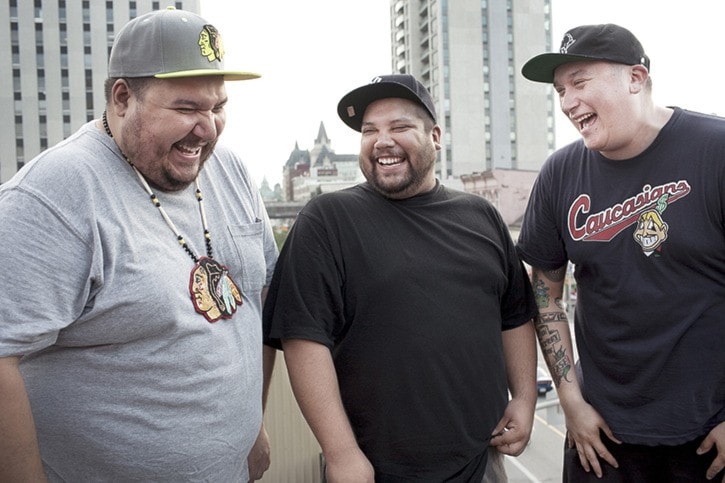A Tribe Called Red never intended to be at the forefront of a First Nation civil rights movement.
But the Ottawa-based DJ trio, comprised of Ian “DJ NDN” Campeau, Dan “DJ Shub” General and Bear Witness, have become ferocious cultural ambassadors since debuting their self-titled, free-download LP in 2012.
“It’s no surprise A Tribe Called Red and Idle No More and all these movements are happening with the first generation that wasn’t forced into residential schools,” says Campeau, from the Ottawa home he shares with his wife and two children, ages four and six.
The DJ crew is fresh off a European tour and back on the North American circuit this month with U.S. stops including Chicago, Seattle and Los Angeles.
Both A Tribe Called Red and 2013’s sophomore release Nation II Nation, are receiving international praise for marrying First Nation tribal powwow with electronic beats. The resulting “electric powwow-step” permeates the bones, an infectious rhythm that sounds like nothing else and often tackles taboo issues head-on (2010’s Woodcarver commemorates the Seattle police shooting of homeless woodcarver John Williams).
The trio began as a duo in 2008, as Bear Witness and NDN were headlining monthly Electric Powwow nights at an Ottawa nightclub. DJ Shub, a two-time Canadian DMC champion and former Red Bull Thre3style Canadian champ, vibed well during guest sets, and was invited into the crew in 2010.
“Dan is an incredible producer on top of DJ’ing,” Campeau says.
Central to ATCR’s vision is a deliberate “recontextualization” of First Nation culture, he says.
Bear Witness doubles as a visual producer to create political and tongue-in-cheek videos during live sets that incorporate pop culture references to Native people while reclaiming the aboriginal image.
“As First Nation people, we haven’t really had our civil rights movement yet,” Campeau says. “After researching and seeing what happened with the Black civil rights movement in the States, a lot of it was because of friction, they had to face each other all the time. With First Nation people, we’re all on reserves. So it’s a lot of out of sight, out of mind sort of thing.”
The use of social media in uniting hundreds of First Nation cultures has been fundamental in restoring pride amongst a new generation, Campeau says.
“We see the Internet and social media being a huge part of our success,” he says. “We’ve definitely been able to shake a lot of the stereotypical ideas of what most people think First Nation people are in a contemporary sense. We’re definitely something that people will think of when they think of Aboriginal music now – which is half electronic music – which wasn’t necessarily the case even five years ago. So I feel we’ve successfully changed the idea of what a contemporary First Nation person is today.”
The buy-in among their own nations – the Anishnabe from Nipissing First Nations and Upper Cayuga, Six Nations – and the wider Native community is a massive motivator for the crew as they reach new audiences.
“Read the comments section in any newspaper regarding any First Nation issue and you’ll see how a lot of people see First Nation people,” Campeau says. “But it’s also completely misinformed, and that’s something that needs to be discussed, and that’s starting now. … Even five years, if you asked somebody to think of a Native person in their mind, they wouldn’t necessarily think of a guy in a hoodie, jeans and Nikes, it would typically be buckskin and a horse. The idea of what First Nation people are is shifting.”
